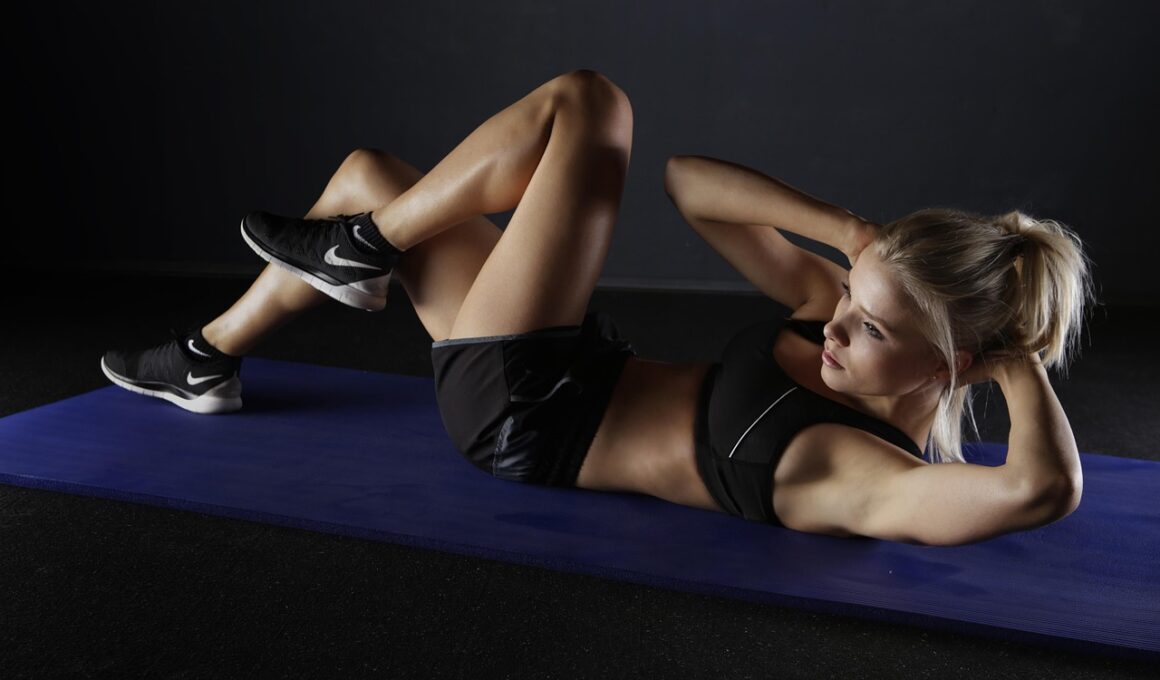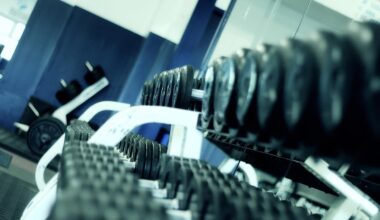Bodyweight Core Workout Plans for Different Fitness Levels
Core stability is essential for nearly any type of fitness activity, making bodyweight core exercises vital for all levels. Beginners should focus on mastering foundational exercises that build strength without overwhelming the body. Exercises such as the plank, glute bridge, and side-lying leg lifts are excellent starting points. As strength develops, gradually increase the duration and intensity of hold times in these positions. Beginners should aim to perform these workouts three times weekly. It’s also crucial to listen to your body, adjusting routines as necessary to avoid injury. Core exercises not only enhance fitness performance but also improve posture and reduce injury risk. By regularly incorporating these foundational moves into your routine, you’ll create a solid base of strength, allowing for progression into more advanced variations. Additionally, remember to complement your core work with proper nutrition and hydration strategies for best results. Stick with it, and soon you’ll notice significant improvements in core stability and overall fitness levels. Emphasizing the importance of consistency will help in achieving your fitness goals. Everyone should strive for a strong core, regardless of their current fitness level.
Essential Bodyweight Core Exercises for Beginners
Beginners can start integrating effective bodyweight core exercises to build a strong foundation. Simple moves like the dead bug and bird dog aid in developing coordination and balance while engaging core muscles. The dead bug involves lying on your back, arms extended towards the ceiling, and alternating legs while maintaining lower back contact with the floor. Similarly, the bird dog effectively enhances stability and works the lower back. Perform 2-3 sets of each exercise, aiming for 10-15 reps per side. Also, the mountain climber adds a cardio component, enhancing endurance while working the abs. As you gain strength, you may transition to more challenging versions. To ensure progression, focus on controlled movements rather than hurried repetitions. Incorporating a variety of exercise types promotes balanced muscle development and overall core stability. It’s essential to prioritize form over quantity for maximum benefit and injury prevention. Each move should be done with a focus on quality. Set realistic goals and progressively increase intensity to avoid burnout. Building a strong core leads to improvements in other areas of fitness and daily activities.
Another effective plan for intermediate fitness enthusiasts is introducing more dynamic movements. Adding variations of classic exercises makes routines more engaging and challenging. Transitioning from planks to plank jacks elevates heart rates while still working core muscles. Likewise, the Russian twist adds rotational movement that targets obliques effectively. Even advancing to single-leg variations can heighten the challenge further, enhancing balance and focus. Each session should include 3-4 sets of exercises with a rep range of 10-15. Scheduling focus days on core training allows for muscle recovery while maintaining strength training in other areas. Testing limits should be encouraged; however, it’s crucial to listen to your body and avoid pain. Furthermore, adding functional movements like burpees and jumping jacks can round out workouts, promoting overall conditioning and endurance. Remember to integrate stretching and cooldown routines. Emphasizing recovery prepares your body for subsequent workouts, minimizing overuse injuries. Allow at least one rest day in your weekly routine to help muscles recover and strengthen. Balance functional training with restorative practices for optimal results in progressing fitness levels.
Advanced Bodyweight Core Workouts for Experienced Fitness Levels
For seasoned fitness enthusiasts, incorporating advanced bodyweight core workouts is essential for ongoing challenge and growth. Complex exercises such as the one-arm plank or ab wheel rollout not only enhance core strength but also test balance, flexibility, and coordination. Engaging in mixed workout sessions that combine dynamic movements can amplify results significantly. For instance, perform a series of push-ups followed by explosive plank-ups for an intense core circuit. Strategically implementing stability training using a balance ball can further elevate challenge levels. Aim for 3-4 sets of each exercise with lower rep ranges (8-12), prioritizing quality and form. Additionally, integrating HIIT (High-Intensity Interval Training) elements alongside traditional exercises promotes endurance and muscle development. Ensure to include active recovery intervals within high-intensity sessions to allow for muscle engagement without overwhelming stress. Focusing on coordination-focused drills further enhances agility while improving overall core stability. Advanced functional training creates efficiency and strength in all body movements. Committing to progressive challenges not only leads to achieving high fitness levels but also boosts confidence in personal training abilities.
Nutrition is another vital aspect impacting core strength and workout performance. Proper diet fuels the body, enhancing energy levels for difficult workouts. Include a balanced mix of proteins, healthy fats, and complex carbohydrates in your daily meals to optimize performance. For core training specifically, protein-rich foods aid in muscle repair and growth, while carbohydrates provide necessary energy levels. Incorporating a variety of vegetables ensures adequate vitamin and mineral intake, vital for recovery and overall well-being. Additionally, staying hydrated plays a vital role in muscle function. Aim for at least half your body weight in ounces of water daily. Pay attention to your body’s hunger cues and fuel appropriately before and after workouts to maximize results. Pre-workout snacks rich in complex carbs enhance energy levels, while post-workout protein aids recovery. Meal prepping may assist in ensuring meals align with training goals. Consistency in nutrition, combined with your diet, offers the best results. Nutrition should complement your training, providing you need to fuel intense core workouts. Following a structured plan can prevent roadblocks and enhance your overall progress in bodyweight core exercises.
Tracking Progress and Adjusting Plans
Continuous improvement in bodyweight core training hinges on tracking progress and adjusting workout plans. Utilize journals, apps, or simple charts to monitor changes in strength, reps, and variations as you advance. Reflecting on specific goals helps assess where to push further while identifying areas needing additional attention. Regularly challenging yourself to maintain or increase rep counts prompts progressive overload, key to muscle growth. It is beneficial to periodically reassess your fitness level and adjust your workouts accordingly. For example, if traditional planks have become too easy, incorporate single-arm variations or add leg lifts to enhance intensity. Creating a well-structured program that evolves as your strength develops helps minimize boredom and enhances engagement. Regular cross-training will help maintain overall fitness levels and reduce the risk of plateauing. Engaging in different workout styles also promotes muscle endurance and balance. Incorporating community challenges, like group classes or online fitness communities, encourages accountability and support. With dedicated tracking and adjustments, sustainable growth is possible. Remember, every individual progresses at their rate; listen to your body, fostering commitments to long-term success in core training.
Finally, staying motivated is a significant factor in continuing your bodyweight core training journey. Setting realistic and achievable goals allows for a sense of accomplishment that propels you forward. Celebrate minor victories, such as mastering a new exercise or increasing rep counts. Joining fitness communities or engaging with workout partners may provide additional motivation. Sharing your progress with others creates accountability, enhancing adherence to workout plans. Incorporate variety to keep routines fresh and exciting by alternating exercises or experimenting with new formats, such as circuits or theme days. Regularly revisiting your goals, adjusting them based on progress, helps in maintaining focus on your training journey. Don’t shy away from incorporating fun movements, as enjoying workouts fosters a positive mindset and consistency. Visualization techniques can also reinforce commitment to training goals; picture yourself achieving fitness milestones. Explore new challenges or competitions to ignite your passion for core workouts. Remember, persistence and passion go hand in hand in achieving lasting success. By fostering a positive approach and keeping your journey enjoyable, maintaining dedication is more manageable while achieving significant fitness developments.


